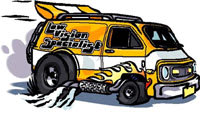|
|
|
Taking Low Vision on the Road
By Barbara Anan Kogan, O.D.
Beginning in 1940, actors Bob Hope and Bing Crosby began their "On the Road" film series. In it, they visited multiple locations-from Singapore and Rio to Morocco and Bali.
Like those stars, today's optometrists and opticians are taking their practices "on the road." One reason? To accommodate their low vision patients.
Here's a look at just how that out-of-office care is being provided:
Health Care Institutions
These facilities run the gamut from hospitals, rehabilitation centers, assisted living residences, and nursing homes. Steve Feinberg, O.D. is a Washington, D.C. practitioner and currently director of Low Vision Services at Howard University, where he also provides out-patient care. Feinberg says, "Nursing home care requires simpler low vision aids and shorter visits because patients often have limited cognitive abilities.
"Low vision is improving the patient's quality of life through improving visual functioning," adds Feinberg. On his calls, he takes the expected-a trial lens set and diagnostic hand instruments-but he also arrives with large print reading material, such as the Reader's Digest and newspapers, a goose neck lamp with an extension cord, and high contrast visual acuity charts instead of fixed charts. A guitarist, he has found that a foldable music stand provides the perfect mechanism for holding the acuity charts.
|
Have Van, Will Travel
Veteran optician Steve Feldman founded his mobile service, "Eyes on the Road," in 1996. With word-of-mouth and doctor referrals, his mobile care "stops" range from assisted living facilities and rehabilitation centers to nursing homes. "I have recently completed updating my low vision knowledge and skills by taking continuing educations courses at Vision Expo West," says Feldman.
In Florida, optometrist Phil Sidran made the decision to go on the road nearly a decade ago. His mobile eyecare office is a van that's equipped with diagnostic tools. He often takes a staffer along to patient exams.
"There is no greater joy," says Sidran, "than to watch a grandparent experience the beauty of a grandchild through their own eyes, and no deeper satisfaction than giving someone who has all but given up the hope of good sight, the gift of seeing."
He says that work in nursing homes sometimes requires unconventional strategies. In the case of hand-held magnifiers, for example, "The patient holds the magnifier directly in front of the eye and brings reading material in until it is readable. Unfortunately, the mental ability of some of the patients in nursing homes is a problem which prevents you from having the time to work with them for low vision exams and device training." What are some of the other challenges? "Dealing with the family and the economics issues" can both complicate care, he says. "Interestingly, though," adds Sidran, "the biggest low vision aid I use in nursing homes is more light! This overcomes the darkness in patients' rooms. I also use high adds with nursing home patients."
Carolyn Carman Merrifield, O.D., has been a low vision specialist since 1987. Nearly half of her practice hours are spent outside of her Arlington, Texas office providing low vision care in a variety of settings, including in-patient rehab centers and hospitals. In fact, explains Merrifield, "approximately half of my practice is comprised of traumatic brain injured patients from children to seniors. This differentiates the single impairment patient, who has, for example, age related macular degeneration."
How does her Texas marketplace compare to others? "Texas has a large percentage of O.D.s who provide low vision care," she says. "And, with the aging of the population, the need for low vision care will only increase for all of us."
Patients' Homes, Schools, and Offices
Both Sidran and Feldman extend their low vision care to patients' homes and offices. In fact, Feldman often visits Washington area government agencies and corporations where his patients are employed.
To promote his services, his Website states: "Extra service at NO extra charge; we specialize in difficult prescriptions, and we are available 24 hours per day, seven days per week."
Meeting specific goals is important. Says Sidran, "I do use high adds of, for example, +12.00 glasses, for an aphake who has low vision. This enables the patient to see the phone book and family pictures."
Since participating in academia is an integral part of Feinberg's long-time involvement in low vision, he explains that "it is appropriate for me to work with low vision children at the schools for handicapped children." He finds that these kids want to do many activities both in and out of school, and says, "This adds to the reward of that care."
Adding Services to Other Offices
Merrifield enables retina specialists, general ophthalmologists, and other optometrists to offer low vision care in their offices. These, she explains, are doctors who "have the desire to extend their services to meet the needs of their patients." Unlike in institutional settings-where she brings a hand-held slit lamp and tonometer, as well as a trial lens set-in doctors' offices, "they provide the diagnostic equipment and, with stock low vision devices, I can dispense on site. However, I also bring low vision devices," she says.
Many say adding a mobile modality will be increasingly important for those who consider low vision an important part of their practice. The biggest benefit, say doctors and opticians who have already done so, is that care on the road offers them the opportunity to meet patients' needs wherever they are-in institutional settings, in their homes and offices, and even at school. EB




